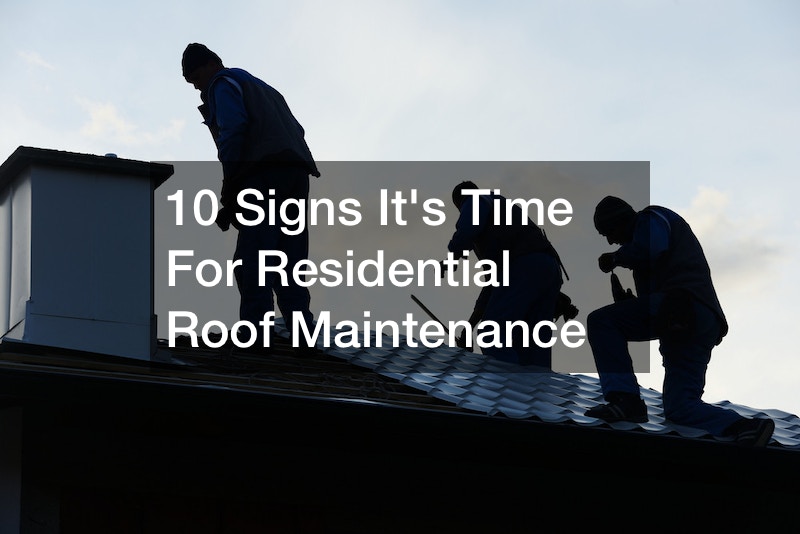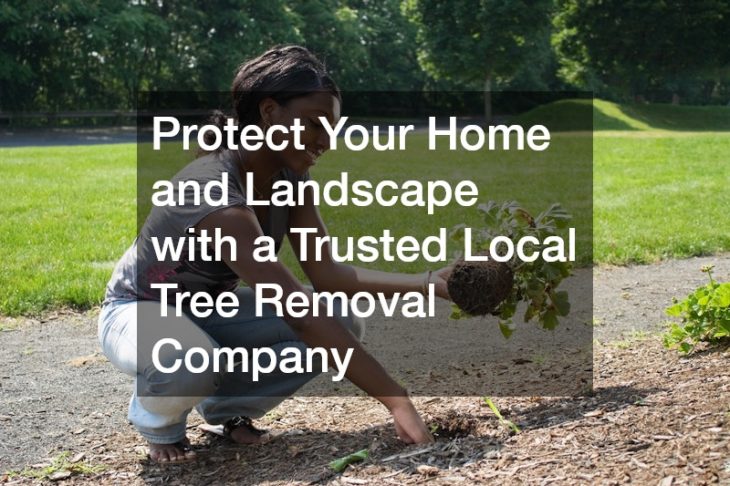
10 Signs Its Time For Residential Roof Maintenance
The roof is one of the most vulnerable features of your home’s exterior, and its strength is tested daily by ultraviolet radiation, rainstorms, hailstorms, strong winds, snowstorms, and sleet. You can do many things to keep your roof in pristine condition, including ensuring you have high-quality materials for your roof and that it’s installed properly. Even better, have a residential roof maintenance schedule that you follow diligently to maintain a watertight roofing system. Ideally, you should inspect your roof biannually, in the spring or fall, and ensure trained professionals do it. Extreme weather events can also prompt an inspection if damage is suspected. This article covers ten instances that necessitate a roof maintenance check.

1. Curling Shingles
Did you know that shingles curl for many reasons, the most common being their age and temperature fluctuations? Here’s the thing: with time, older shingles get weak and tend to curl up when they do. Ventilation problems in your attic can precipitate temperature fluctuations that cause the asphalt to curl. Other culprits for curling are strong winds or an incorrectly installed roof. Either way, whenever you see curled shingles, don’t panic, but get concerned enough to conduct residential roof maintenance immediately, as curled shingles are more often than not an indicator of a greater problem.
It’s possible to repair curled shingles, especially if there are only a few shingles to flatten. Use a propane torch to soften the curled edges of the shingles before straightening them. If your curly problem is more widespread, consider replacing the affected ones. In this case, you’re better off talking to your local roofer or contractor for those who prefer general contracting and having them inspect the roof safely to establish what’s causing the curling. In some cases, the roof is so badly compromised that your only option is to replace it entirely.
2. Missing Shingles
Experienced homeowners know the feeling that follows upon noticing a gap of missing shingles on your roof or when you find some lying in your yard. If you come across shingles in your yard, this is a clear sign that it’s time for residential roof maintenance. Once you spot missing shingles, the possibility of a leaking roof depends on the roof’s age, how well it’s installed, and how often you’ve been conducting roof maintenance. Old roofs are prone to leaks, so missing shingles speeds up the process. Water penetrates the underlying insulation for poorly installed roofs, and any roof that isn’t maintained regularly has a higher chance of leaking.
Quickly replace missing shingles. Ideally, get a local roofer to come and assess how bad your roofing situation is and fix it. If you still have time on your warranty, the replacements or repairs will be done at no cost; if it’s expired, you’ll have to absorb the costs, but you should get it fixed now instead of dealing with a leaking roof nightmare later on.
If the shingles are missing owing to poor installation by your roofer, get them to take full responsibility. Always hire an independent commercial roofer to establish if your roof was professionally installed. If the missing shingles appear to have been ripped off your roof by the wind, consider filing a claim with your insurance company.

3. Sagging Roof
An ideal roof should be level, with flat surfaces that allow water and debris to run off easily. It shouldn’t sag or bend, causing debris to catch or sit on its surface. Unfortunately, roofs can lose this pristine balance over time, and as they age, they aren’t immune to sagging due to several factors.
The four main causes of a sagging roof are water damage, excess weight, poor roof installation, and age. Water damage weakens the roof’s structural integrity, causing it to sag. Excess weight can be exerted on a roof by a broken branch or accumulated snowpack during winter.
Follow a residential roof maintenance routine to repair a sagging roof. Begin by establishing the extent of the damage, so you can determine if it’s a repair or a replacement issue. Conduct the examination internally and externally. Check for signs of structural damage, like rot or mold, large cracks, or broken areas. Sometimes, you can resolve a sagging roof problem by applying simple processes, such as jacking up the loose rafters, increasing the number of struts and supports, or replacing the shingles. However, some problems are much bigger and require help from professional roofers.
4. Clogged Gutters
Never underestimate the importance of gutters to the integrity of your home. When you don’t have gutters, or when they’re damaged or clogged, the resulting spillage and poor drainage result in roof damage, foundation damage, landscape erosion, driveway cracks, and personal injuries. Professional roofing contractors may be expensive for repairing your roof fascia and gutters, but you can avoid difficult cleanups and common emergencies by following simple maintenance practices.
A residential roof maintenance schedule must include gutter maintenance. Clean your gutters so they don’t get clogged up by debris buildup. Check for loose gutters during the cleaning and ensure they’re securely fastened to the eaves. Install a drip edge to protect your fascia from the water draining from your roof. As you conduct routine gutter maintenance, inspect the caulking between the gutter’s edge and the roof to see if the caulking layers have gaps or cracks. Replace the caulking if this is the case.

5. Higher Energy Bill
Energy efficiency is today a top priority among most homeowners. Your roof plays a significant role in regulating the temperature in your home and reducing energy consumption. It protects against sun heat, atmospheric cold, and other environmental factors. However, the insulation properties can be compromised over time, increasing energy consumption. Ensuring proper roof sealing and insulation is among the most effective ways to promote energy efficiency. Poor insulation, characterized by gaps and leaks, can result in energy inefficiencies that require the attention of local roofing repair services.
Cool roofing materials are ideal for warmer climates. They’re made of material that reflects the sunlight, causing the roof to absorb less heat. This can significantly reduce fueled cooling costs. If you notice heat building up in your attic, contact a residential roof maintenance service to inspect your attic vents. Old roofs are less energy-efficient compared to modern roofs. Therefore, even if your roof is structurally sound, if it’s too old, you might want to replace it with a modern one to improve energy efficiency.
6. Algae Growth
Left to its own devices, your roof collects dirt, leaves, twigs, moss, lichens, algae, and fungi. Algae can cause dark, unsightly stains and growth on your roof, which get worse every year until you invest in a residential roof maintenance service provider. Algae is a nonflowering plant that mostly lives in water and doesn’t have roots or leaves. Roof algae can develop at humid temperatures with high heat and moisture levels, like in coastal areas. They grow fastest in shady and damp areas, like beneath large trees.
Roof algae is more of an eyesore than anything else. However, roof mold is a different story; it can cause real damage to your roofing system. Algae can be particularly detrimental to metal roofs because it settles and grows on accumulated dirt on the roof. As it grows, it binds the damp soil particles while consistently maintaining high moisture levels on the roof sheet, speeding up the corrosion of iron and steel roofing sheets. Consult your roofer on the advantages of a metal roof in your area and how to conduct metal roof repair if necessary.

7. Water Damage
When was your last residential roof maintenance service? Many homeowners hardly think about it unless there are obvious issues like damage or a leak. Always maintain your roof to protect your house from water and wind. If you intend to do this yourself, avoid walking on the roof. Instead, use scaffolding and a ladder to access the gutters and eaves. Leaks usually result in water damage, so making good use of waterproofing contracting and doing regular inspections around your home can help keep your roof leak-free.
When looking for signs of a roof leak, watch out for curled-up, cracked or missing shingles, damaged gutters, and worn-out seams around the chimney and vents. This is the first obvious check in your quest to prevent water damage from roof leaks, which can encourage mold growth and jeopardize your family’s health. It usually starts in the ceiling or attic. If the air in this area is musty, and when it rains, there are traces of black-stained water in the ceiling and along the wall, this is the time to watch out for roof leaks. A leaking roof could start a fire, especially if you have shorted wires in the ceiling or attic.
8. Tree Damage
While roof damage from trees can be abundantly evident, sometimes it’s not. However, a residential roof maintenance schedule can help you flag roof issues, especially after a storm.
Trees around your roof can cause damage to your roof. The next time you encounter missing shingles, they were probably scooped off your roof by tree branches.
Broken or cracked shingles may also result from falling branches. Algae growth and mold in tree-shaded areas could also compromise your roof, as are leaves and twig litter that clog up the gutters. Besides, you might get unwelcome animal guests as they can easily access your home by climbing nearby trees. You might also have fruits and nuts constantly falling on your roof, causing further damage and necessitating emergency roof repair services.
To prevent roof damage from nearby trees, have proper tree maintenance practices on your property. Consult a professional arborist, an expert in tree maintenance, especially for larger trees. They’ll help you understand the health of the trees, what steps to take, and at what intervals to safeguard you, the tree, and your roof. Routine pruning of your trees prevents roof damage from drooping and dropping branches.
9. Visible Exterior Light
A roof lantern is among the dominantly appealing features of a house. Because it’s made of glass, it needs cleaning after some time, even those with a low maintenance coating. The best and most inexpensive way to do this is to use a non-abrasive sponge with warm, soapy water. Hiring qualified roofing service providers is recommended because of the risks involved in a roof lantern cleanup. Roof lanterns are exposed to the elements; thus, they get soiled by dust, bird droppings, and other forms of pollution.
Sometimes, it’s difficult to establish if your roof leaks as water droplets could form and fall due to condensation. If it’s a leak, it’ll generally correlate constantly with certain weather conditions. Condensation is more likely to happen during cold weather and in damp conditions, whether it rains or not. Signs like the appearance of green algae indicate a leak from the outside. Condensation can sometimes be unavoidable, especially when the temperatures are low. To solve this problem, use more than the recommended insulation requirement in the area.
10. Cracked Shingles
During shingle manufacturing, volatiles are introduced into the asphalt mix to make roofing shingles. Volatiles have a low boiling point, responsible for asphalt shingles’ flexibility and waterproofing capabilities. They break down and disappear from your asphalt shingles over time, making them dry up, shrink, and eventually crack. This shingle cracking process increases with more exposure to heat. Mostly, cracks are a sign of aging or low-quality asphalt shingles. Seek clarification from your local roofing company in case you have such issues.
Shingle cracks increase the risk of roof leaks and wind damage. To avoid this, conduct a residential roof maintenance service upon realizing your shingles are cracked. Don’t be intimidated by the cost of shingles or entire roof replacements. Your roofer can recommend shingle repairs, which are done by applying a generous bead of roofing sealant beneath the crack. The shingle is then pressed down, and a second bead of sealant is applied on top of the crack. You can use a putty knife to spread the sealant.
It’s clear the dangers of a damaged roof are many, leaking being one of the worst. Luckily, you now understand the causes of roof damage and the importance of having a residential roof maintenance schedule to ensure the sustained integrity of your roof. Whenever you encounter any of the signs above, don’t ignore them; take swift action to address the issue and never again suffer the consequences of an improperly maintained roof.

